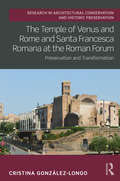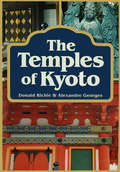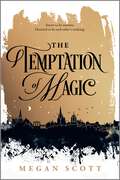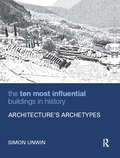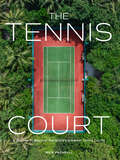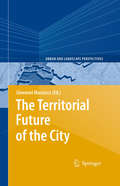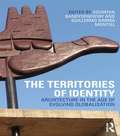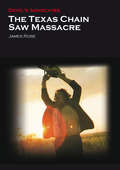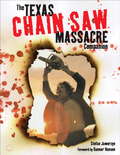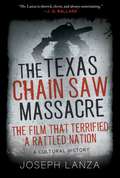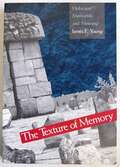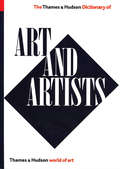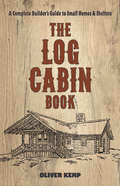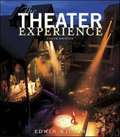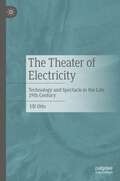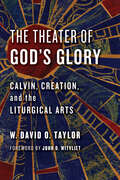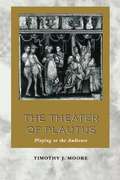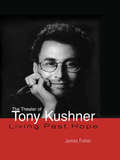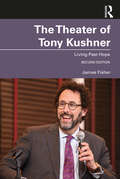- Table View
- List View
The Temple of Venus and Rome and Santa Francesca Romana at the Roman Forum: Preservation and Transformation (Routledge Research in Architectural Conservation and Historic Preservation)
by Cristina González-LongoThis book examines the influence of architectural design in the conservation of historic buildings by discussing in detail an important building complex in Rome: the Temple of Venus and Rome, the monastery of Santa Maria Nova and the church of Santa Francesca Romana. As the most complete site in the Roman Forum that has reached our times with a rich architectural stratification almost intact, it is a clear product of continuous preservation and transformation and it has not been studied in its complexity until now. The Temple of Venus and Rome and Santa Francesca Romana at the Roman Forum unravels the original designs and the subsequent interventions, including Giacomo Boni’s pioneering conservation of the monastery, carried out while excavating the Roman Forum in the early twentieth century. The projects are discussed in context to show their significance and the relationships between architects and patrons. Through its interdisciplinary focus on architectural design, conservation, archaeology, history and construction, this study is an ideal example for scholars, students and architects of how to carry out research in architectural conservation.
The Temples of Kyoto
by Donald Richie Alexandre GeorgesThe Temples of Kyoto takes you on a journey through these environs and presents twenty-one of these marvelous structures that are unique creations which, while quintessentially Japanese, somehow speak a universal languagereadily appreciated by people the world over. Donald Richie, called by Time magazine, "the dean of art critics in Japan," turns his attention to these twenty-one temples with scholarship and an eye for the dramatic. Drawingoff such classic sources as The Tale of Genji and Essays in Idleness, he takes the reader on a tour through the ages, first with a comprehensive history of Japanese Buddhism, and then by highlighting key events in the development of these "celestial-seeming cities." From the Tendai warrior-priests of Enryaku-ji to the floating vision of paradise at Byodo-in, to the magical gardens of Tofuku-ji, the past springs into the present and the temples truly take on a life of their own in a thrilling narrative that weaves fact and legend into a guide as entertaining as it is informative. Brilliant photographs of the temples, taken by the award-winning photographer Alexandre Georges, complement the text and provide a visual overview of the subject matter. His keen eye captures on film the elements that make each temple noteworthy, including their interiors, and objets d'art, in a fresh and thought provoking manner. The result is this book: a testament and meditation on the power and elegance of these world-renowned structures that are both places of worship and examples of the finest art Japan has ever produced.
The Temporality of Building: European and Chinese Perspectives on Architecture and Heritage (Routledge Research in Architectural History)
by Yun Gao Nicholas Temple Jing XiaoThis book examines the role that time plays in the life of buildings, adopting a comparative study of this influence between European and Chinese traditions. Whilst issues of time in architecture have attracted increasing interest by academics in the West, challenging the dominant modernist precepts of space, there is little understanding of the subject in China and how these compare to historical and contemporary perspectives in Europe. A guiding premise of the investigation is that notions of building time require insight into how cultural habits commingle with natural rhythms, or what David Leatherbarrow calls “concurrency”.Rather than examining specific buildings, the first three chapters apply three key themes (language, ritual and heritage) as cultural lenses to reveal differences and similarities between the two traditions. Through these lenses, buildings, interiors and their exterior spaces (churches/cathedrals, temples, palaces, gardens and courtyard houses) are explored to demonstrate how building time involves particular situations/settings and their correlating relationships to past traditions. In the final chapter we consider notions of time in the context of contemporary buildings in Europe and China, drawing on the earlier historical investigations and addressing globalising influences.This book would be of interest to architects, architectural theorists, historians, philosophers, sociologists and anthropologists.
The Temptation of Despair
by Werner SollorsIn Germany the end of World War II calls forth images of obliterated cities, hungry refugees, and ghostly monuments to Nazi crimes. Drawing on diaries, photographs, essays, reports, fiction and film, Werner Sollors makes visceral the sorrow and anger, guilt and pride, despondency and resilience of a defeated people--and the paradoxes of occupation.
The Temptation of Magic
by Megan ScottAn International Bestseller!Perfect for fans of A Discovery of Witches and Serpent & Dove, this mesmerizing dark academia romantasy debut delves into a dangerous supernatural society hidden within our own—where forbidden love and immortal hunters collide, and a dark truth may unravel the entire world.Nicole Palmer and her family have been in hiding for years from the Wake—a shadowy organization that governs all supernatural creatures. If the Wake discovers that Nicole is an Empyreal—a rare kind of creature that can shapeshift into any creature&’s natural predator—they&’ll force her to join them or kill her for resisting. Like they did her mother. Nicole is close to uncovering a secret message hidden in a supernatural art collection—a message from her mother about how to destroy the Wake for good. But when the collector is murdered and a key painting stolen, the Wake sends their best Empyreal assassin to track down the dangerous creature on the loose. Kyan McCarter is handsome, perceptive, and the last person Nicole wants to work with to find the stolen painting. Their search sparks a powerful connection between them, but if Kyan finds out that Nicole is a rogue Empyreal, he&’ll have no choice but to hunt her next. After all, no one disobeys the Wake and survives.
The Ten Most Influential Buildings in History: Architecture’s Archetypes
by Simon UnwinEven the most inventive and revolutionary architects of today owe debts to the past, often to the distant past when architecture really was being invented for the first time. Architects depend on their own imaginations for personal insights and originality but their ideas may be stimulated (consciously or subliminally) by particularly powerful buildings from history. The Ten Most Influential Buildings in History: Architecture's Archetypes identifies ten architectural archetypes that have been sources of inspiration for architects through the centuries. Each archetype is analysed through distinctive examples, following the methodology established by the author in his previous books. The variety of 'lines of enquiry' each archetype has provoked in latter-day architects are then explored by analysing their work to reveal ideas inspired by those earlier buildings. Archetypes have a timeless relevance. In adopting this approach, The Ten Most Influential Buildings in History is as pertinent to contemporary practice as it is to understanding buildings from antiquity, and offers insights into the bridges of influence that can operate between the two.
The Tennis Court: A Journey to Discover the World's Greatest Tennis Courts
by Nick PachelliA fresh approach to a beloved sport, The Tennis Court is a photographic journey of the 200 most breathtaking tennis courts around the world. &“Nick Pachelli takes us on court in every corner of the world with a sharp eye for what makes our game and the people who champion it so special.&” —Billie Jean King, sports icon and equality advocate Every one of the world&’s half a million tennis courts is, at its most basic, an identical blank canvas: a 78-foot by 36-foot rectangle, divided by a 3-foot-high net in its center, and marked with eleven straight lines. But add in the elements of surface, space, wind, acoustics, crowds, shadows, humidity, and even air density, and every tennis court is unique—a work of art. And some are masterpieces. Nick Pachelli curates and profiles 200 of the world&’s most beautiful, iconic, significant, alluring, and idiosyncratic tennis courts from across the globe, each breathtakingly photographed. He explores the heavyweights, including Wimbledon&’s All England Lawn Tennis Club, which employs a hawk to keep stray birds from soiling the meticulous lawns. Arthur Ashe, the Grandstand, and Court 17 in Flushing, Queens, where hundreds of thousands of tennis fans gather every summer for the US Open. And there&’s Court Philippe-Chatrier at Roland-Garros, whose clay seems to take on a different shade—burnt orange, burnt red, burgundy, umber—every time you see it. We visit far-flung treasures, such as Waiheke Tennis Club in New Zealand, where you&’ll need to take a plane, then a ferry, then a car or bus, and then walk before arriving there. Indoor marvels, including the Tennis Club de Belgique, which evokes the hushed, reverent feeling of a theater, with skylights illuminating the court and leaving the spectators in the shadows. Hidden jewels, such as the tiny Tennis Club San Stin in Venice, a secret, single outdoor clay court tucked away behind a villa and a 15-foot wall shrouded with vines. There are urban courts, including the Knickerbocker Field Club, deep in the heart of Flatbush, Brooklyn. Academies, like Rafael Nadal&’s tennis temple in Mallorca, Spain. And the extreme: a single court completely isolated in the wilds of Scotland; a court in northern Spain revealed when the tide goes out, the sand hardens, and the metallic plates that serve as lines reemerge; and a court in Kenya made out of termite mounds. Throughout, Pachelli not only conducts a masterful, once-in-a-lifetime tour of the world&’s best courts, but in his writing does something equally immersive: He captures the real passion—some might say obsession—that tennis inspires. Because it&’s on the court, no matter how grandiose or mundane, whether in an exotic locale or around the corner, where tennis players truly see themselves. Where we come face-to-face with our temperament, our drive, our frustration, our bliss, our longing.
The Territorial Future of the City
by Giovanni MacioccoThe volume brings together contributions by leading scholars and young academics with experience in the urban potential of the territory in situations not necessarily linked to the dense metropolis, its compact form or to city sprawl. What brings these scholars together is their common reflection on this central theme, though from varied disciplinary and experimental backgrounds. They offer new forms of representing social and spatial processes of the contemporary society.
The Territories of Identity: Architecture in the Age of Evolving Globalization
by Soumyen Bandyopadhyay Guillermo Garma MontielThe expedited globalised process of exchange and new forms of cultural production have transformed old established notions of identity, calling into question their conceptual foundations. This book explores the spatial and representational dimension of this phenomenon, by addressing how the reshaping of the key themes of place, architecture and memory are altering the nature, as well as, our understanding of identity. Cutting across boundaries, the book drives discussion of identity beyond the well-worn concern for its loss within a globalised context, and importantly provides links between identity, place, memory and representation in architecture. Examining a range of case studies from Australia, Germany, India, Japan, Mexico, Poland, Puerto Rico, Turkey and Singapore, as well as with contributions cutting across geographical and temporal boundaries, this volume addresses such issues as architecture technology, place and memory – critical issues in the monitoring and mapping of identity shift within a rapidly globalising context. With contributions from renowned authors in the field including Nicholas Temple, Patsy Hely, Robert Brown, Liane Lefaivre, John Hendrix, Ana Souto, Fiona MacLaren, Stephen Walker, Nezar AlSayyad, Andrzej Piotrowski, Catherine Ettinger, Luz Marie Rodríguez, and Raymond Quek this book presents fresh insights and diverse perspectives on the evolving question of identity and globalisation.
The Texas Chain Saw Massacre
by James RoseAs well as providing a summary of the making of the film, James Rose discusses the extraordinary censorship history of the film in the UK (essentially banned for two decades) and provides a detailed textual analysis of the film
The Texas Chain Saw Massacre
by James RoseNo-one who has ever seen the original The Texas Chain Saw Massacre (1974) is ever likely to forget the experience. An intense fever dream (or nightmare), it is remarkable for its sense of sustained threat and depiction of an insane but nonetheless (dys)functional family on the furthest reaches of society who have regressed to cannibalism in the face of economic hardship. As well as providing a summary of the making of the film, James Rose discusses the extraordinary censorship history of the film in the UK (essentially banned for two decades) and provides a detailed textual analysis of the film with particular reference to the concept of 'the Uncanny'. He also situates the film in the context of horror film criticism (the 'Final Girl' character) and discusses its influence and subsequent sequels and remakes.
The Texas Chain Saw Massacre
by Stefan JaworzynIn 1974, a low-budget, no-star horror movie was unleashed on the world, causing panic among the censors and provoking glee from its intended audience. The Texas Chain Saw Massacre is still as powerful today as when it was first seen almost thirty years ago, and will return to the screens in a high profile remake this Halloween. Now, in this long-awaited companion to Tobe Hooper's groundbreaking film, Stefan Jaworzyn gives us the inside story of one of the most successful, controversial and influential horror films ever made, as well as in-depth coverage of the three sequels, various documentaries and other movies also based on the life of serial killer Ed Gein. Packed with exclusive interviews, rare and unseen pictures, and with a foreword from the chainsaw-wielding Leatherface himself, Gunnar Hansen!
The Texas Chain Saw Massacre (Devil's Advocates Ser.)
by James RoseNo-one who has ever seen the original The Texas Chain Saw Massacre (1974) is ever likely to forget the experience. An intense fever dream (or nightmare), it is remarkable for its sense of sustained threat and depiction of an insane but nonetheless (dys)functional family on the furthest reaches of society who have regressed to cannibalism in the face of economic hardship. As well as providing a summary of the making of the film, James Rose discusses the extraordinary censorship history of the film in the UK (essentially banned for two decades) and provides a detailed textual analysis of the film with particular reference to the concept of 'the Uncanny’. He also situates the film in the context of horror film criticism (the 'Final Girl’ character) and discusses its influence and subsequent sequels and remakes.
The Texas Chain Saw Massacre: The Film That Terrified a Rattled Nation
by Joseph LanzaWhen Tobe Hooper’s low-budget slasher film, The Texas Chainsaw Massacre, opened in theaters in 1974, it was met in equal measure with disgust and reverence. The film—in which a group of teenagers meet a gruesome end when they stumble upon a ramshackle farmhouse of psychotic killers—was outright banned in several countries and was pulled from many American theaters after complaints of its violence. Despite the mixed reception from critics, it was enormously profitable at the domestic box office and has since secured its place as one of the most influential horror movies ever made. In The Texas Chainsaw Massacre and Its Terrifying Times, cultural critic Joseph Lanza turns his attentions to the production, reception, social climate, and impact of this controversial movie that rattled the American psyche. Joseph Lanza transports the reader back to the tumultuous era of the 1970s defined by political upheaval, cultural disillusionment, and the perceived decay of the nuclear family in the wake of Watergate, the onslaught of serial killers in the US, as well as mounting racial and sexual tensions. The Texas Chainsaw Massacre and Its Terrifying Times sets the themes of the film against the backdrop of the political and social American climate to understand why the brutal slasher flick connected with so many viewers. As much a book about the movie as the moment, Joseph Lanza has created an engaging and nuanced work that grapples with the complications of the American experience.
The Texture of Memory: Holocaust Memorials and Meaning
by James E. YoungIn Dachau, Auschwitz, Yad Vashem, and thousands of other locations throughout the world, memorials to the Holocaust are erected to commemorate its victims and its significance. This fascinating work by James E. Young examines Holocaust monuments and museums in Europe, Israel, and America, exploring how every nation remembers the Holocaust according to its own traditions, ideals, and experiences, and how these memorials reflect their place in contemporary aesthetic and architectural discourse. The result is a groundbreaking study of Holocaust memory, public art, and their fusion in contemporary life. <p><p>Among the issues Young discusses are: how memorials suppress as much as they commemorate; how museums tell as much about their makers as about events; the differences between memorials conceived by victims and by victimizers; and the political uses and abuses of officially cast memory. Young describes, for example, Germany's "counter monuments," one of which was designed to disappear over time, and the Polish memorials that commemorate the whole of Polish destruction through the figure of its murdered Jewish part. He compares European museums and monuments that focus primarily on the internment and killing process with Israeli memorials that include portrayals of Jewish life before and after the destruction. In his concluding chapters, he finds that American Holocaust memorials are guided no less by distinctly American ideals, such as liberty and pluralism. <p><p>Interweaving graceful prose and arresting photographs, the book is eloquent testimony to the way varied cultures and nations commemorate an era that breeds guilt, shame, pain, and amnesia, but rarely pride. By reinvigorating these memorials with the stories of their origins, Young highlights the ever-changing life of memory over its seemingly frozen face in the landscape.
The Thames and Hudson Dictionary of Art and Artists (Expanded, Updated) (World of Art)
by Herbert Read"Excellent, concise . . . highly recommended." --Choice This extensively illustrated dictionary provides information on over 2,500 artists, paintings, sculptures, drawings, prints, schools and movements throughout the world, including entries on contemporary art and artists, techniques, materials, terms, and writers who have influenced artists.
The Thames and Hudson Encyclopedia of the Italian Renaissance
by J. R. HaleWithin the vast literature of the Renaissance, this is the one indispensable book: for the student who wants a guide to the complicated maze of Italian Renaissance political history.
The The Log Cabin Book: A Complete Builder's Guide to Small Homes and Shelters
by Oliver KempThis vintage guide from over a century ago offers timeless, practical advice on building log cabins. Plans and directions for simple structures are easy enough for amateurs to follow; time and inclination are the only necessary elements. Each of the designs has been tested and allows numberless alterations to suit the builder's tastes and requirements. Instructions range from selecting a site and safe, efficient methods of cutting down trees for building materials to building an ice house and boathouse to furnishing and decorating interiors. Photographs and drawings provide clear images for a variety of wilderness homes, including floor plans for The Block House, Wildwood, Crow's Nest, Idlewild, and other rustic retreats. Rich in nostalgic charm as well as useful applications, this manual offers priceless guidance to handymen, woodworkers, and hunters as well as those interested in small houses, construction, and home history and seekers of off-the-grid, environmentally friendly living.
The Theater Experience (10th Edition)
by Edwin WilsonThe ideal theater appreciation text for courses focusing on theater elements, The Theater Experience encourages students to be active theater-goers as they learn about the fundamentals of a production. By addressing the importance of the audience, Wilson brings the art of performance to life for students who may have little experience with the medium.
The Theater of Electricity: Technology and Spectacle in the Late 19th Century
by Ulf OttoSince the 1880s, electrical energies started circulating in European theaters, generated from fossil fuels in urban power plants. A mysterious force, which was still traded as romantic life force by some and for others had already come to stand in for progress, entered performance venues. Engineering knowledge, control techniques and supply chains changed fundamentally how theater was made and thought of. The mechanical image machine from Renaissance and Baroque times was transformed into a thermodynamic engine. Modern theater turned out to be electrified theater. – Retracing what happened backstage before the Avantgarde took to the front stage, this book proposes to write the genealogy of theaters modernity as a cultural history of theater technology.
The Theater of God's Glory: Calvin, Creation, and the Liturgical Arts
by W. David TaylorA theological framework for the liturgical arts rooted in John Calvin Both detractors and supporters of John Calvin have deemed him an enemy of the physical body, a pessimist toward creation, and a negative influence on the liturgical arts. But, says W. David O. Taylor, that only tells half of the story. Taylor examines Calvin's trinitarian theology as it intersects his doctrine of the physical creation in order to argue for a positive theological account of the liturgical arts. He does so believing that Calvin's theology can serve, perhaps surprisingly, as a rich resource for understanding the theological purposes of the arts in corporate worship. Drawing on Calvin's Institutes, biblical commentaries, sermons, catechisms, treatises, and worship orders, this book represents one of the most thorough investigations available of John Calvin's theology of the physical creation—and the promising possibilities it opens up for the formative role of the arts in worship.
The Theater of God's Glory: Calvin, Creation, and the Liturgical Arts (The Calvin Institute of Christian Worship Liturgical Studies (CICW))
by W. David TaylorA theological framework for the liturgical arts rooted in John Calvin Both detractors and supporters of John Calvin have deemed him an enemy of the physical body, a pessimist toward creation, and a negative influence on the liturgical arts. But, says W. David O. Taylor, that only tells half of the story. Taylor examines Calvin's trinitarian theology as it intersects his doctrine of the physical creation in order to argue for a positive theological account of the liturgical arts. He does so believing that Calvin's theology can serve, perhaps surprisingly, as a rich resource for understanding the theological purposes of the arts in corporate worship. Drawing on Calvin's Institutes, biblical commentaries, sermons, catechisms, treatises, and worship orders, this book represents one of the most thorough investigations available of John Calvin's theology of the physical creation—and the promising possibilities it opens up for the formative role of the arts in worship.
The Theater of Plautus: Playing to the Audience
by Timothy J. MooreThe relationship between actors and spectators has been of perennial interest to playwrights. The Roman playwright Plautus (ca. 200 BCE) was particularly adept at manipulating this relationship. Plautus allowed his actors to acknowledge freely the illusion in which they were taking part, to elicit laughter through humorous asides and monologues, and simultaneously to flatter and tease the spectators.<P><P>These metatheatrical techniques are the focus of Timothy J. Moore's innovative study of the comedies of Plautus. The first part of the book examines Plautus' techniques in detail, while the second part explores how he used them in the plays Pseudolus, Amphitruo, Curculio, Truculentus, Casina, and Captivi. Moore shows that Plautus employed these dramatic devices not only to entertain his audience but also to satirize aspects of Roman society, such as shady business practices and extravagant spending on prostitutes, and to challenge his spectators' preconceptions about such issues as marriage and slavery. These findings forge new links between Roman comedy and the social and historical context of its performance.
The Theater of Tony Kushner (Studies in Modern Drama)
by James FisherThe Theater of Tony Kushner is a comprehensive portrait of the life and work of one of America's most important contemporary playwrights.
The Theater of Tony Kushner: Living Past Hope
by James FisherThe Theater of Tony Kushner is a comprehensive portrait of the forty-year long career of dramatist Tony Kushner as playwright, screenwriter, essayist, and public intellectual and political activist.Following an introduction examining the influences of Kushner’s development as an artist, this updated second edition features individual chapters on his major plays, including A Bright Room Called Day, Hydriotaphia, or The Death of Dr. Browne, Angels in America, Slavs! Thinking About the Longstanding Problems of Virtue and Happiness, Homebody/Kabul, Caroline, or Change, and The Intelligent Homosexual’s Guide to Capitalism and Socialism with a Key to the Scriptures, along with chapters on Kushner’s adaptations, one-act plays, and screenplays, including his two Academy Award-nominated screenplays, Munich and Lincoln.A book for anyone interested in theater, film, literature, and the ways in which the past informs the present, this second edition of The Theater of Tony Kushner explores how his writings reflect key elements of American society, from politics and economics to race, gender, and spirituality, all with the hope of inspiring America to live up to its ideals.
